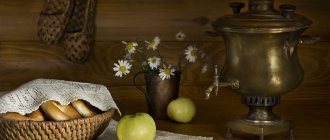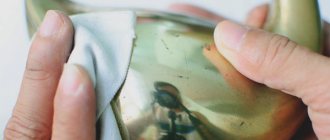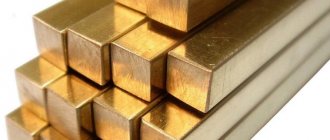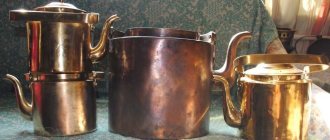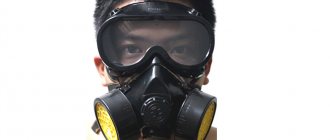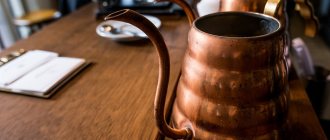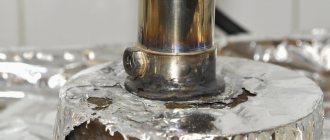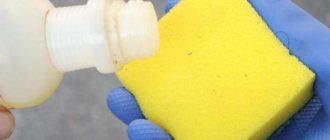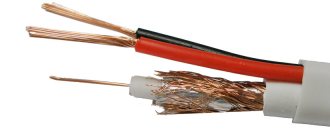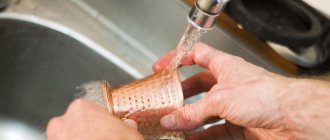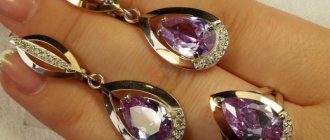Copper belongs to the category of materials that undergo corrosion when exposed to aggressive environments. As a result, material deterioration occurs, gradual destruction and loss of normal performance qualities.
In many ways, the features of the process and its dynamics may differ depending on the environment, temperature conditions and other characteristics.
Let's consider in what environments the material begins to deteriorate most quickly and how to further protect it from the rusting process.
Why copper rusts and how to protect it from corrosion
Copper products have been used by humans for several centuries.
In pre-revolutionary times, the price of this metal was equal to the cost of gold, its production was so expensive. Now copper has become much cheaper, so in addition to jewelry, it is used to make dishes, interior accessories and other items. Corrosion of copper, unlike iron, develops slowly due to its resistance to this phenomenon, and yet sometimes it is necessary to take measures to clean products from unsightly plaque.
The influence of impurities on the deterioration of metals
It is known that metals in their pure form are practically not subject to corrosion. But in practice, all materials contain some amount of impurities. How do they affect the safety of products during use? Let's assume that there is a part made of two metals. Let's consider how corrosion of copper and aluminum occurs. When exposed to air, its surface is covered with a thin film of water. It should be noted that water decomposes into hydrogen ions and hydroxide ions, and carbon dioxide dissolved in water forms carbonic acid. It turns out that copper and aluminum immersed in a solution create a galvanic cell. Moreover, aluminum is the anode, copper is the cathode (aluminum is to the left of copper in the voltage series).
Aluminum ions enter the solution, and excess electrons pass to the copper, discharging hydrogen ions at its surface. Aluminum ions and hydroxides combine and are deposited on the surface of aluminum as a white substance, causing corrosion.
What is corrosion of metals and alloys
Corrosion refers to the process of destruction of metal under the influence of aggressive environmental factors. To one degree or another, all metals and alloys rust, as a result of which rust and areas of integrity damage (holes) appear on them. Non-metals can also deteriorate over time: an example is the aging of rubber or plastic from interaction with oxygen, frequent contact with water, and temperature changes.
The main cause of corrosion is considered to be the thermodynamic instability of the metal to the influence of physical factors or chemical substances that are present in the contact medium. Compared to iron, copper oxidizes much less, but with increasing temperature this process accelerates significantly. When regularly exposed to an environment with temperatures above +100 degrees, any metal rusts several times faster.
Electrochemical corrosion
This is the most common type of destruction of metal products. Electrochemical corrosion destroys machine parts, various structures located in the ground, water, atmosphere, and cutting fluids. This is damage to the surface of metals under the influence of electric current, when, during a chemical reaction, electrons are released and transferred from cathodes to anodes. The heterogeneous chemical structure of metals contributes to this. When copper comes into contact with iron in an electrolyte, a galvanic cell appears, where iron becomes the anode and copper becomes the cathode, because iron in the voltage series according to the periodic table is to the left of copper and has greater activity.
In a pair of iron and copper, corrosion of iron occurs faster than copper. This happens because when the iron breaks down, electrons from it go to the copper, which remains protected until the entire iron layer is completely destroyed. This property is often used to protect parts and mechanisms.
Corrosive properties of copper
Copper is a metal with high plastic properties, having a red-golden color, and after removing the oxide film - slightly pinkish. In terms of electrical conductivity, it is second only to silver, and is also characterized by high thermal conductivity. Due to its low resistivity, copper is used in electrical engineering: it is used to make copper plates, wires, and motor windings.
Due to its high anti-corrosion qualities, the metal is included in alloys to improve their technical characteristics (bronze, brass and others). In a galvanic environment, copper becomes a cathode, enters into electrochemical processes and causes accelerated rusting of other metals.
Copper is an inactive chemical element, therefore it practically does not interact with air or water (fresh, sea). If the air is dry, an oxide film up to 50 million thick is formed on the surface of the material. The copper product darkens, becomes brown or greenish, this is called patina. In some cases, patina is perceived as a decorative coating. The intensity of corrosion is low upon contact with dilute hydrochloric acid, but when reacting with a number of other acids, with halogens, and “regia vodka,” the metal is oxidized to form copper carbonate.
Search data for your request:
Many people have copper products at home. These can be kitchen utensils, antique coins, buttons, interior items and even jewelry. Unfortunately, one of the properties of copper is oxidation upon contact with certain substances, and it can also darken over time.
How to clean copper products at home and restore their original shine and beauty? Sometimes, copper products are specially patinated to give the effect of antiquity; in other cases, this is a consequence of unintentional oxidation.
Cleaning copper products at home is possible using both special and folk remedies.
Search data for your request:
Schemes, reference books, datasheets: Discussions, articles, manuals:
Wait for the search to complete in all databases. Upon completion, a link will appear to access the found materials.
WATCH THE VIDEO ON THE TOPIC: Galileo. Experiment. Copper cleaning
Composition for protection against oxidation during heating of copper and ee alloys
Copper jewelry is valued not only for its beauty, but also is believed to have health benefits. But unlike more expensive gold items, copper jewelry requires little care to avoid oxidation.
When oxidized, copper rings and bracelets not only become coated, they also leave unsightly green stains on the skin. This happens when copper reacts with air and water to form copper carbonate.
Copper oxidation, although unsightly, is not harmful to health, but can be avoided with proper cleaning and daily care. Today, several methods are known to protect metal from rust.
Regardless of the chosen method of protection, the protection only applies. We advise you to take the drawing that you want to translate and make a reverse drawing from it through the glass.
Then coat the metal surface with an aqueous solution. In addition to the chemical etching of metals described above, there is another method of etching using a galvanic battery.
Advantages of the method Iron products to be polished are immersed for some time in a mixture consisting of 1 part sulfuric acid to 20 parts by volume of water, then the object is removed. In addition to the galvanic method, you can use the following, very simple method for coating polished steel or iron with a thin, but very durable etching is a method of reproducing designs, ornaments, inscriptions, etc. using chemical means.
I think many people have encountered the problem of hardening metal products, or rather, on the contrary, the lack of it.
For example, today it is difficult to find a good one. That beautiful malachite or bluish-green coloring that ancient bronze products possess occurred under the influence of very long exposure. Under the influence of oxygen, a beautiful black-brown layer is formed on the surface of the copper.
To speed up this process, they resort to artificial oxidation. Multi-colored mordants and dyes for brass products. Small brass items such as buttons, clasps, buckles, etc.
Welding machines Repair Cars and motorcycles Counters Security and protection Do-it-yourself crafts Brick production Paints, varnishes and inks Cosmetics and perfumes Working with wood Precious metals Ideas for business Homemade machines Working with metal Putty, grease and glue Schemes and drawings Energy Home mini-factories.
Use the site search:. For the home handyman Putty, grease and glue Paints, varnishes and inks Working with metal Working with wood Repair Mini-production Brick production Methanol production Weaving chain-link mesh Home mini-factories Homemade products Metal detectors Security and protection Welding machines Other homemade products Drag.
Auto and motorcycle Ideas for business Schemes and drawings Household meters Homemade machines. Alternative energy Auto and motorcycle Woodworking Metal detectors Drag. How to protect copper products from plaque formation. Clean your brass thoroughly with an acidic cleaner and, if necessary, a toothbrush.
There are many suitable cleaning products available in stores, but lemon juice, vinegar and even ketchup also contain enough acid for basic cleaning, and salt can be used as an abrasive to scrub away the most stubborn stains. Rinse the copper piece to remove any cleaning agent, then neutralize any remaining acid. Dip the item in a mixture of 1 part baking soda and 16 parts water. Rinse the jewelry again with clean water and dry.
Lubricate all surfaces of the product with xylon or denatured alcohol. Wait until it is completely dry. Cover the copper piece with a thin layer of wax and polish until shiny.
Jewelry wax can be purchased at a jewelry store, but car wax is also great. Before going to bed, be sure to remove all copper jewelry and dry it with a soft, clean cloth to remove sweat and oil.
After these daily treatments, your copper jewelry will require less cleaning and polishing to maintain its best appearance.
Material failure conditions
Despite their resistance to damage, even copper products can rust under certain conditions. Such phenomena are least expressed in humid air, water, soil, and more pronounced in an acidic environment.
Corrosion can be seriously reduced by tinning - coating copper with a layer of tin. High-quality tinning provides reliable protection from damage, increases corrosion resistance, and makes the material not susceptible to high temperatures, rain, hail, and snow. The service life of tinned products is more than 100 years without loss of original properties.
Water influence
The rate of copper corrosion in water strongly depends on the presence of an oxide film on its surface, as well as on the degree of oxygen saturation of the water. The higher the content of the latter, the more intense the destruction of the material occurs. In general, copper is considered resistant to the harmful effects of salt and fresh water, and is only adversely affected by dissolved chlorine ions and low pH levels. Strength and resistance to rust allows the material to be used for the manufacture of pipelines.
If there is a brown or green oxide crust on the surface of a copper-plated product, destructive substances penetrate inside to a small extent. Typically, the oxide layer forms after 60 days of the metal being in water. The green crust (carbonate) is considered more durable, while the black (sulfate) crust is loose and less strong.
In sea water the level of corrosion is almost the same as in fresh water. Only when the movement of the liquid accelerates does corrosion become impact, and therefore more intense. Copper is a material that is not capable of being overgrown by marine microorganisms, because its ions are destructive to mollusks and algae. This property of the metal is used in shipping and fishing.
Exposure to acids and alkalis
Copper does not deteriorate in alkalis, because the material itself is alkaline, but acids are the most harmful in terms of their effects. The most significant and rapid corrosion occurs upon contact with sulfur and its acidic compounds, and nitric acid completely destroys the structure of the material.
Effect of acid and alkali
Corrosion of copper in acidic environments is less detected. The effect of nitric and sulfuric acid will be the strongest. If you place it in a concentrate of these acids, it can completely dissolve. These features are taken into account when choosing alloys for elements and pipelines in the oil and gas industry.
In an alkaline environment, the effect is not observed at all, since alkali allows copper to be reduced from a 2-valent to a 1-valent state. It is worth remembering that it itself is an alkali metal.
Protection against oxidation and corrosion under the influence of acids is carried out by inhibitors - substances that slow down the chemical reaction. The following types can be distinguished:
- · Shielding – form protective lashes and exclude the possibility of contact with acids.
- · Oxidative – the formation of an oxide occurs, which reacts with acids, thereby preventing their penetration into the metal structure.
- · Cathode – designed to increase the overvoltage of the cathodes of the solution, due to which chemical reactions reduce their intensity.
As a rule, corrosion of copper in acidic environments is prevented by shielding type inhibitors. The most common is benzotriazole, which, together with copper salt formations, forms a protective shell, slowing down the rate of corrosion or almost completely stopping it.
Why copper products need to be cleaned regularly
Copper pots, ladles, and samovars are distinguished by high thermal conductivity, so heating in them proceeds evenly and food cooks faster. This determines the high popularity of products in everyday life. The need to clean copper objects is due to their loss of visual appeal over time. Products that are exposed to air or frequently heated up fade and lose their natural color especially quickly.
Oxide film - patina - is popular only where it is required to give things a vintage look, antique stylization. Otherwise, it spoils the appearance of dishes, utensils, jewelry and figurines. To remove oxide deposits, darkening elements and restore shine, you will have to periodically clean the items. Cleaning is also required to prevent harmful compounds that may be present in the black or green layer from getting into the food.
Effective Copper Cleaning Methods
Cleaning copper items is easy and does not require expensive products. Here are the most popular techniques used at home:
- Ketchup. Take a little tomato ketchup, lubricate the product with it, and leave for two minutes. Then rinse with running water.
- Dishwashing solution. Lather a household sponge with regular dish soap, wipe the surface thoroughly, and rinse with water. This method is best for items that are only slightly faded.
- Lemon. Rub the copper surface with a slice of lemon, then go over it with a stiff bristled brush and wash with water.
- Vinegar and flour. Pour a little vinegar into a cup, add flour until you get a medium-thick dough. Lubricate the copper with the dough, leave until dry, then remove the residue and rub the product with a soft cloth.
- Vinegar and salt. Pour 9% vinegar into a stainless steel pan, add a little salt, and let it boil. Turn off the heat, put a copper object into the solution, do not remove it until the liquid cools. This method is suitable for heavily soiled surfaces.
Cleaning samovars and teapots
All methods are also suitable for cleaning copper samovars, teapots and Turks. It’s just that it’s a little more difficult to clean the inside, because limescale deposits appear there from boiling water. One proven method is to use potato peelings:
- After peeling the potatoes, leave the skins, wash them, pour them inside the dishes and pour boiling water over them.
- Boil water with potato peelings for three hours.
- Then drain the contents of the dishes and wash them in the usual way using detergent.
After such cleansing, you need to boil water in a copper bowl a couple of times, replacing it with a new one each time to remove any remaining plaque.
Another proven method is to use lemon zest. Skins from tangerines, oranges, and limes are also suitable. Then proceed like this:
- The skins are placed in the vessel, filling half the container with them. Instead of zest, you can take two packs of citric acid.
- Pour in a little water - do not fill it completely, otherwise the liquid will begin to splash out when boiling.
- Boil for half an hour, then drain the water and clean the walls of the product with a brush.
The procedure is repeated if necessary. You can also use store-bought products to descale teapots.
But detergents for washing machines and dishwashers are not suitable for copper cookware: they are more aggressive and can damage the copper surface. The selected purchased product is used strictly according to the instructions indicated on the package.
In the case of a samovar, it is recommended to disassemble it into its components before cleaning, since many different curved parts cannot be washed so easily by simple boiling.
If stains appear on copper utensils, you should not be upset; you can resort to different methods and means that give good results. It is quite easy to restore a copper surface to its former beauty.
Cleaning Copper Coins
Copper coins are antiques and are not issued in modern times. They often have to be cleaned to restore their attractive appearance. If the coin has been in contact with lead, the coating may be yellowish. In this case, it can be easily cleaned with table vinegar (9%). Green plaque is removed with a solution of citric acid (10%) or lemon juice, brown plaque is removed with ammonia or ammonium carbonate.
It must be remembered that sometimes a layer of patina gives coins a more noble and vintage look, so it is not always advisable to remove it. Some, on the contrary, try to artificially age money at home. To do this, you need to take a liter of distilled water, 5 g of pharmaceutical potassium permanganate, 50 g of copper sulfate. Heat the solution without boiling, throw coins into it, and leave until the desired shade is achieved. To consolidate the effect, treat dried money with a mixture of benzene and alcohol (1:1). Afterwards, the coins will acquire a beautiful aged appearance and will be able to decorate any collection of antiques.
Source
Clean a copper basin at home
As a rule, a copper basin is used to make jam. Such dishes have good thermal conductivity, antiseptic properties, are safe for humans, and when cooking the jam practically does not stick to the walls.
If the jam is still burnt, the copper basin can be cleaned with vinegar dough. For this ancient method, you need to knead the dough by mixing flour and table vinegar. Next, the dough is rolled out thinly and placed on the dirt.
After the mixture dries, carefully remove it. The vinegar paste absorbs dirt, making the surface perfectly clean.
Features of different types of aggressive environments
The type of damage and the rate of corrosion of copper directly depend on the atmosphere in which it is located. Even the highest quality materials cannot withstand strong aggressive influences for a long time.
Next, we describe the main types of media and their effect on the material.
Copper parts can be used in a variety of aquatic environments. The composition of the liquid, the speed of its movement and other important characteristics change.
The main parameter influencing the intensity of the process is the presence of an oxide film that has already formed on the surface of the material.
There are several parameters that influence the process in an aquatic environment:
- Flow intensity . Corrosion of copper in water increases when the flow moves at high speed. In this case, the rusting process will be called impact.
- Degree of aeration . The more oxygen in water, the higher the rate of impact corrosion. This is especially true for water with low hardness and a significant degree of chlorine content.
- Climatic zone . Typically, in warm and humid areas, the speed of the process becomes much faster.
- Composition of water . As with other types of metals, seawater poses the greatest danger to copper. There is a significant risk of developing electrochemical corrosion of copper upon contact of several types of metal products located close to each other. But there is also an advantage - biological rusting is excluded, because harmful marine microorganisms do not survive on copper surfaces. When used in clean water, the danger is much less, which is why copper pipes are often used for installing heating and water supply systems in the private sector.
Sometimes destruction can be stimulated by unexpected catalysts. One of them is the passage of water through severely worn out utility networks. If there is a large amount of iron in the water, there is a high risk of starting an electrochemical process.
It is also worth paying attention to what materials are located next to copper products in conditions of high humidity.
Among the most dangerous are aluminum and zinc.
A universal solution to the problem of using pipes in utility networks is the use of tinned copper in the process of their manufacture. In this case, the inside of the pipe is coated with tin.
The cost of production becomes higher, but the process pays for itself by increasing the duration of use without replacement.
Atmospheric exposure
This type of material is one of the most durable on the market when it comes to outdoor applications.
The main property of the material in this case is the possibility of the gradual appearance of an oxide film (patina). It is the patina that becomes a natural protective coating that limits the contact of this type of raw material with many types of potential oxidizing agents.
In this way, an effect similar to galvanizing is achieved, but without the use of additional impurities and compounds.
Due to its tendency to patina, copper can be freely used outdoors. This is often used by architects when they need to provide roofing, create small architectural forms and solve other issues as part of a comprehensive landscaping.
The rate at which patina appears may vary depending on the climate zone, average temperatures and other features.
The likelihood of negative effects of the atmosphere increases if there are a lot of foreign impurities in the air. Corrosion begins to develop especially often in places where there are a lot of chlorides and sulfides dispersed in the air.
The soil
When answering the question of whether copper can rust when the product is placed in soil, it is important to take into account the main parameter of the soil - pH or the degree of alkalinity.
The higher it is, the greater the acidity. Since acids negatively affect the condition of copper and trigger the corrosion process, it is better not to use the material in highly alkaline soils.
Another potential danger factor is a high concentration of soil microorganisms.
The problem is that during their life they emit hydrogen sulfide.
This is another substance that negatively affects both copper itself and its numerous alloys.
Exposure to soil and moist air
Corrosion of copper in the soil is mainly caused by the influence of acids contained in the soil. Compared with the effects of water, oxygen in the soil oxidizes metal elements much less. The most dangerous microorganisms in the soil are, or rather, their secretions. They are often capable of releasing hydrogen sulfide, which destroys metal. Thus, copper lying in the soil for a long time can completely decompose.
In humid air the process does not proceed rapidly. It takes a long time. In a dry climate, destructive effects may not be observed at all. This is explained by the fact that in humid air there is a high concentration of carbon dioxide, sulfides, chlorides, which cause corrosion and are destructive to the protective film.
Prolonged exposure to humid air can cause the formation of a patina layer. This is the name given to green deposits on copper. It consists of salt oxides, which are initially dark brown in color, and then the surface begins to turn green. The peculiarity of patina is that it cannot be dissolved in water and is not affected by high air humidity. It has neutral properties to copper itself, which allows it to protect the surface from the harmful effects of the environment. In addition, modern methods of creating artificial patina make it possible to use it in objects of art and during restoration.
Can tinned copper rust?
It was noted above that one of the means of combating corrosion of copper pipes is the use of the tinning process - applying a layer of tin to the inner surface. But it is important to understand that this is not a panacea for a metal product.
The tin coating itself becomes the anode. This means that in relation to copper it has a more negative potential.
The main condition for protection against rust is that there are no cracks or other defects on the tin layer. If they do appear, corrosion of copper in air proceeds much faster.
How to restore shine
Having wiped off plaque and dirt from a copper product, you need to restore the original shine to maintain decorative properties. There are several polishing options that can be easily performed at home.
Crumpled newspaper
The easiest and most effective way to restore its original shine is to polish it with regular newspaper. You need to roll up a couple of sheets of newspaper into a ball and wipe the tarnished areas with it.
Constantly using this method, you can quickly restore the condition of the products.
Vinegar dough
A dough mixed from vinegar essence and wheat flour is suitable not only for combating stains, but also for polishing. The only difference is that to polish the dough you need to add a pinch of table salt. A mixture of these components is applied to the surface of the object and left until dry. To avoid damaging the coating, it is important to ensure that the salt particles are dissolved before application.
Hydrochloric acid solution
It is recommended to use hydrochloric acid in the most extreme situations. A powerful solution that restores shine after rubbing the surface. For safety reasons, when working with the substance, you need to wear protective gloves and a mask, and open the windows in the room for ventilation.
Kerosene and chalk
A mixture of kerosene and chalk chips is applied to a soft sponge and the metal coating is wiped until a characteristic shine is formed. This processing method is suitable for cleaning and finishing products.
Using toothpaste or powder
Abrasives, including toothpaste and powder, contain ingredients that remove tarnish from metal surfaces. The composition is applied to the darkened areas and rubbed in with light force with a soft sponge. Then all that remains is to rinse the residue with heated water and wipe the coating dry.
How to make copper products shine
Cleaning copper products to a shine is possible in the following ways:
- applying lemon juice, citric acid solution;
- polishing with special pastes;
- galvanic method, using copper as an anode;
- by heating a mixture based on citrus juices inside a copper container.
In which environments can and cannot be used copper?
With proper processing, the material will last more than 100 years without corrosion. But it is important to understand where copper will be resistant to corrosion catalysts, and where there is a high risk of its occurrence.
It is safest to use the material outdoors and in fresh water, regardless of the degree of cooling or heating. In sea water, the material also remains undamaged for a long time and retains its performance characteristics.
You also don’t have to worry about the safety of the copper part if there are no strong oxidizing agents in the environment.
Danger can potentially arise if there is a lot of hydrogen sulfide in the soil, water or air, carbonic acid, salts of heavy metals, and amines.
When water is highly aerated, there is also a significant risk of impact corrosion and other types of gradual deterioration.
Therefore, when purchasing such material, it is very important to understand where you will use the copper product, and what external threats will affect it during operation.
Precautions when cleaning copper
When cleaning with aggressive agents, safety precautions must be observed:
- read the instructions carefully;
- use rubber gloves;
- if necessary, wear a protective mask to avoid burns to the respiratory tract caused by cleaning agent vapors;
- when mechanically cleaning copper, use plastic goggles to protect your eyes from foreign bodies;
- in case of contact with the skin or eyes, immediately rinse the area with water or seek medical attention;
- To avoid damage to copper, it is not recommended to leave the product in acid for a long time, and also to use iron brushes and abrasive substances.
What not to do
To avoid damaging the surface of the products, the following actions are prohibited:
- cleaning with abrasive materials;
- the use of chemicals that contain acids;
- heating objects in the presence of oxidizing substances or environments;
- removal of protective varnish coatings by chemical or mechanical means;
- leave copper objects in dusty places for a long time without carrying out wet cleaning.
It is important to strictly follow safety precautions when cleaning, especially when using strong chemicals. To remove contaminants, different cleaning methods can be used.
About the importance of cleaning
To extend the life of your product, it should be cleaned regularly.
Gradually, most types of household appliances and other materials may lose their presentation and become dull due to the formation of an oxide film.
This is a beautiful means for aging dishes or other types of products, but many people do not like the presence of patina.
There are several common cleaning methods that can help remove the patina and leave the underlying material undamaged:
- Special solutions for washing dishes . In this case, the surface becomes more susceptible to the removal of the oxide film. If it has appeared recently, it will be possible to remove the oxidation products without making any serious efforts.
- Lemon acid . It can be used both as part of a solution and by simply applying a freshly cut slice to the surface. Patina is removed quickly and effectively.
- Vinegar . Has the same effect as lemon. To improve the effect, it is often mixed with salt or flour.
And this is only part of the methods that can be used to combat patina.
How to care for copper products?
There are several recommendations regarding the proper care of copper items. They will help preserve the natural appearance of the metal for as long as possible, so do not neglect them.
There are several such recommendations:
- Copper utensils must be kept clean regularly. After each use, wash thoroughly and dry with a towel. Residual moisture may cause the surface to turn black.
- For cleaning, do not use abrasive substances, as well as products containing chlorine and ammonia. To prevent scratches on the surface, do not use metal spatulas, spoons, or coarse bristled brushes for cleaning.
- Copper jewelry should be wiped with damp wipes as often as possible. This is necessary in order to remove sebum from their surface.
- Products should only be washed by hand, do not use a dishwasher.
If you follow these fairly simple tips, you can significantly extend the life of copper products, as well as maintain their natural shine.
How to protect copper from corrosion
There are many products that can help reduce the likelihood of corrosion in various environments. Among them are:
- Changing the composition of the material . The use of alloying can significantly increase the level of corrosion resistance. In this case, the impurities may be different - the main thing is to take into account the area of use of the finished part and understand the potential risks in order to eliminate them.
- Tinning . The process involves treatment with liquid tin. An effective protective layer is created on the surface. Provided there are no defects, it will limit contact with the atmosphere and other factors leading to corrosion.
- Control over the area of use . When purchasing copper products, it is important to understand where you will be using them. It is necessary to protect the material from contact with sulfur and its compounds, and to prevent zinc or aluminum parts from being located nearby. They can provoke the appearance of electrochemical corrosion.
Taking into account the standard requirements for the use of copper products will significantly increase their service life and prevent problems with corrosion.
Source
Useful tips and tricks
It is worth adhering to the following recommendations to maintain the shine of copper products for a long time:
- To preserve the natural copper shine of objects for a long time, you can use a protective varnish coating. For example, cheap copper jewelry can be coated with clear nail polish. This method allows you to isolate the product from contact with the air atmosphere and human skin, which will preserve its shine for a long time. Besides nail polish, you can also use beeswax. This product can be found in relevant stores.
- Do not use abrasives or steel objects when cleaning copper metal as they are harder than soft copper and can severely scratch the product.
- Heat and humidity are the enemies of copper cookware, as they significantly accelerate their destruction and blackening. To avoid continued exposure to these factors, store the product under appropriate conditions, such as a dry, ventilated cabinet.
- It is not recommended to cook food containing a lot of acids in copper cookware at high temperatures. Products containing acids, such as vinegar, fruits, tomatoes and others, cause serious harm to copper products.
- Most decorative items are coated with a protective varnish layer. Such items should be washed only with warm water and soap and do not use abrasive materials or polish these items, as all this can damage the protective coating. In addition, products with a protective coating require special care, so it is recommended to follow the manufacturer's instructions.
- Some copper food utensils have a protective coating that must be removed before using the utensils for their intended purpose. There are two ways to remove the coating: place the product in boiling water with a small amount of baking soda, or thoroughly wipe the product with a cotton cloth soaked in alcohol or acetone, and then rinse under running water.
- Do not forget to wipe copper products with a damp, clean cloth, not allowing dust and dirt to accumulate on them.
Home methods for cleaning black on copper products should be used from time to time as needed, but you need to understand that the items will become thinner each time.
This is interesting: Melting point of brass and bronze: melting at home
